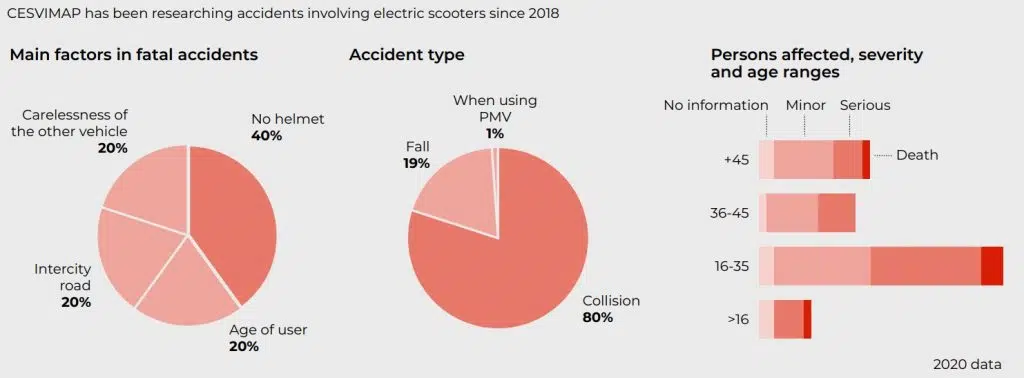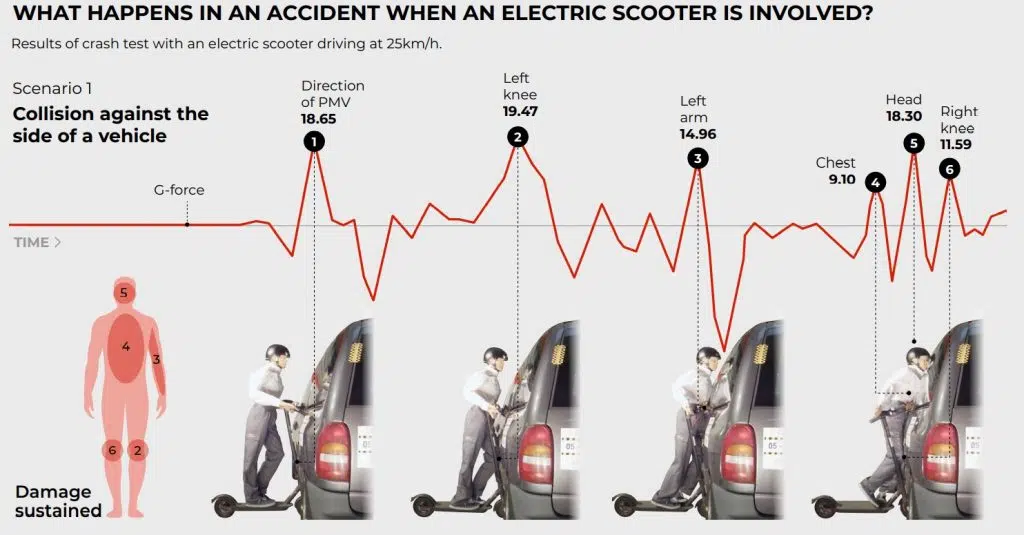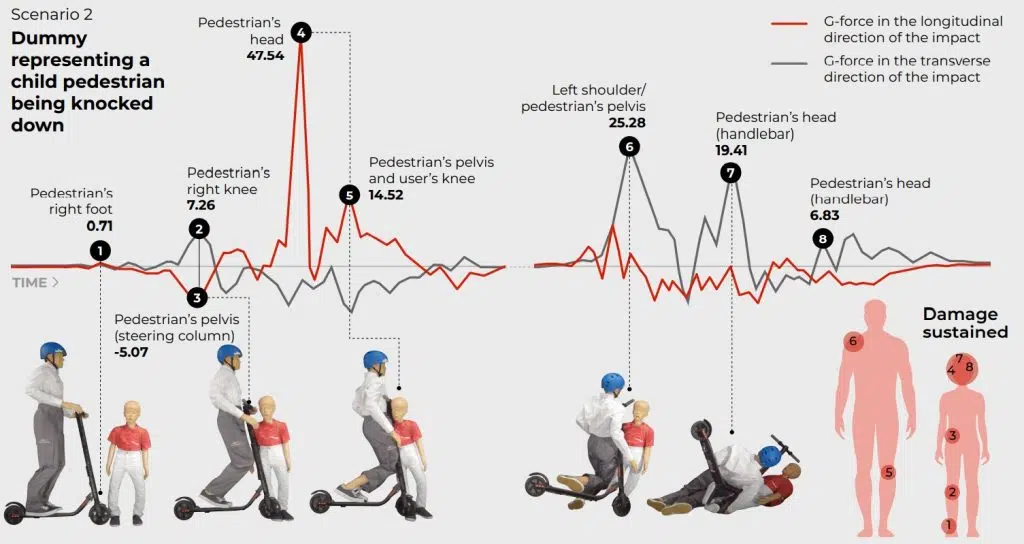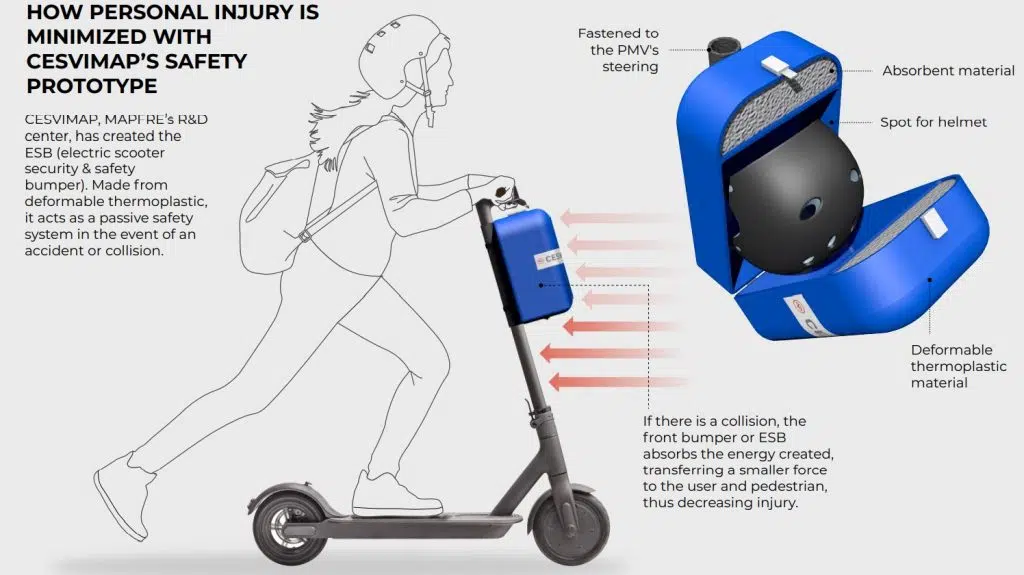INNOVATION| 15.09.2022
Safety on two wheels: the CESVIMAP prototype that limits injuries caused by accidents involving electric scooters

Neus Martínez
Almost four years have passed since the first death caused by an accident involving an electric scooter in Spain. As things stand in 2022, personal mobility vehicles (or PMVs) now form part of the urban landscape, and to some, seem to be gradually invading our streets. With the aim of enhancing user safety, CESVIMAP, MAPFRE’s R&D center, has developed a passive safety prototype that reduces by 85% the g-force exercised on a child’s head when hit by an electric scooter.
Just a few weeks before that fateful day in October 2018, which claimed the life of the first person to die in a scooter-related accident, the first speeding fine was handed out to an electric scooter user. It was at this time that this fledging model of micro and shared mobility carved out a space for itself in our cities, which it has now come to dominate. We’re talking about a new form of mobility that’s closely linked to the essential need to be part of the sustainability movement.
Electric micromobility: the metamorphosis of cities
The COVID-19 pandemic saw us mark, and cross, a line in the sand in terms of how we see mobility in cities: things changed rapidly, and with the focus shifting to individual transport, in the space of just a few short months, we quickly got used to personal and shared electric scooters and bicycles.
The positive impact of sustainable mobility is evident. It starts by changing our habits and helps us make the switch to getting around in such a way that reduces CO2 emissions, offering an option to cut our reliance on private vehicles, reducing congestion on the streets through an alternative that’s good value for money and which is at the same time, driving rapid growth in a new segment.
Micromobility also has the potential to form part of the strategy for the design of urban transport networks, against a backdrop in which the need to think of more human and sustainable cities is to the fore. This context forms part of the so-called “last mile”, which relates to trips covering very short distances. The use of electric scooters is inherent to micromobility, moving people and goods while releasing fewer emissions and reducing costs.
The rapid adoption of new transport habits translates into PMV market penetration figures that are very impressive. In 2020, at the height of the pandemic, Spain smashed the record for bicycle sales with more than 1.5 million units sold. By the end of 2019, electric scooters had made their way into 6.7% of Spanish homes. And 2021 saw 280,000 scooter units being sold, up almost 500% on the figure for 2019.
But are PMVs as effective when it comes to safety?
In 2019, the Spanish Highway Association and the Accident Prevention and Road Safety Area at Fundación MAPFRE published New personal mobility systems and the problems they pose in relation to road safety, a study that addressed road safety and sustainable mobility with electric scooters The work took a dual perspective: it provided an analysis of the regulatory framework in different Spanish provinces and took an in-depth look at accident rates in Spain. At the time, there were no official details available for these vehicles, meaning the information was gathered using articles on PMVs published in the media. This study, which also included the perception of citizens about this new means of transport, gave rise to the “3S (Safe, Sound and Sustainable) Mobility Manual)”, which included a new player in our cities: electric scooters.
In 2021, CESVIMAP, in collaboration with the Accident Prevention and Road Safety Area at Fundación MAPFRE, published the conclusions of a study called Electric scooter crash tests and risks associated with their recharging process: recommendations for safe use. This was the first research work of its kind in Spain to offer a timely and accurate overview of accident levels with scooters. The crash tests were conceived to ensure these vehicles are designed safely, focusing on the analysis of the most common accidents involving electric scooters.

In addition to providing detailed information about how accident rates have evolved in recent years, the focus of the research had a pioneering goal in mind: to develop a safety system that would absorb the impact of an accident. The ESB prototype (electric scooter security and safety bumper) is designed in such a way that “the energy transferred in the accident to the scooter user is much lower and consequently, the injuries sustained are less serious”, asserted Jorge Garrandés, head of micromobility at CESVIMAP.
Micromobility with macrosafety: the ESB prototype
Accidents, collisions and falls are the most common incidents involving electric scooters. Since 2018, the use of personal mobility vehicles has skyrocketed, and as PMVs must obey traffic regulations, many users have taken to the streets in an apparent regulatory oasis.
Infractions like riding without lights at night, using the sidewalk or traveling at more than 25 km/hr, involve an increase in risk for riders themselves, because users bear the brunt of the impact of an accident, given that they don’t have the same protection as other vehicle users. The Directorate General of Traffic published a Resolution on January 12, 2022 following the approval of the Personal Mobility Vehicle characteristics manual.
This new regulation establishes a series of standardized and enforceable technical requirements that include aspects such as the braking system to be used by scooters, the type of lighting they must be equipped with, the manufacturer’s accreditation in relation to temperature sensors, among numerous other stipulations, all of which have a common objective in mind: harmonizing the process of certifying PMVs for personal and commercial use (sharing services or goods transport) and the use, classification and safety of same.
In this critical context of safety, the aforementioned study (Electric scooter crash tests and risks associated with their recharging process: recommendations for safe use) from CESVIMAP also presents the results of controlled crash tests performed in a laboratory that reproduce the two main types of collision involving electric scooters: user impact when traveling at a speed of 25 km/h into the side of a vehicle and a collision between a user traveling at the same speed and a child pedestrian.
The consequences of an accident with an electric scooter
To understand the impact on the human body of a collision, we must first understand the influence that “g-force” has. The tolerance of this measurement of speed will depend on the magnitude, duration of acceleration or deceleration and orientation of our body.
A 1 g acceleration is considered standard gravity and, under normal circumstances, people are not subjected to more than 8 g for one second. However, any sudden movement increases this g-force, meaning that if we’re traveling in a car without a seatbelt, even a minor impact will result in your body hitting the windshield. Putting this into context, an airline pilot weighing 88 kg who is subject to a force of 9 g will have the sensation that they weigh almost 800 kg. Imagine the impact of your body with that weight!
As part of the CESVIMAP research, consideration was given to the two most common scenarios seen in cities: an electric scooter crashing into a vehicle and a collision with a child pedestrian. The results of these simulations can be seen in the accompanying table, which compares accidents involving an electric scooter equipped with the ESB system and one without.


How does the safety system reduce damages?
The ESB acts as a passive security system in the event of an accident or collision. It is made from deformable thermoplastic material that cushions the g-force of the impact.

In the video, you can see how the system absorbs and reduces the energy transmitted to the scooter user as part of the impact against the vehicle, thereby minimizing personal injury.
The ESB prototype also comes with an additional safety feature in the form of a smart helmet. This was tested in a simulation of a collision with a child pedestrian and the result was startling. The g-force exercised on the head of a child when the ESB prototype is not used is 47.54 g; however, in the simulation using the ESB, this drops to 7.06 g: a reduction of 85%. The difference is crucial: rather than suffering serious injury, the child would suffer minor injury.
R&D at the service of society
The law on the use of personal mobility vehicles is progressively evolving, but there is still significant room to improve active and passive safety and innovation has a major contribution to make in the medium and long term.
“Personal safety is the priority” says Francisco J. López Valdes, coordinator of the master’s degree in Mobility and Safety (M2S) at Comillas Pontificia University. This university, which CESVIMAP has collaborated with on a range of projects, has also studied the most common accidents involving scooters, the causes of these accidents and the types of injury sustained. In collaboration with CESVIMAP, simulations have shown that wearing a helmet greatly reduces the risk of injury in an accident.
THUMS (Total Human Model for Safety) is a virtual human modeling software (written in open source code, and developed by Toyota) to analyze the bodily injuries caused in vehicle collisions by computer. These virtual dummies will help to improve vehicle safety bby digitally projecting personal injury and damage to objects caused by accidents.
The development of the safety system for ESB scooters by MAPFRE’s R&D center supports the new regulations and provides an innovative and easy-to-implement solution, which will be key in ensuring safe mobility for everybody.
